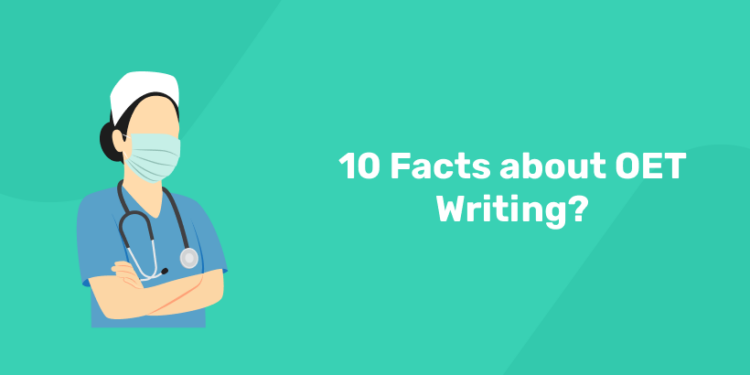Table of Contents
Did you hear of the 10 facts about OET Writing? In this article we are going to discuss each of these facts in detail. These essential tips will help the nurses and medical professionals preparing for the OET writing section. OET, or the Occupational English Test, assesses the English language proficiency of healthcare professionals. This exam focuses on communication skills in medical field.
Get your Desired OET Scores in Weeks! Get a Free Demo Class Here!
10 Facts about OET Writing:
Discussed below are the 10 Facts about OET Writing.
1. Navigating Task Types in OET Writing
Understanding Task Diversity
OET writing tasks encompass a range of formats, each demanding a unique approach to effectively convey information. Familiarizing yourself with these task types is essential for crafting cohesive and purposeful responses.
Diverse Task Requirements
Tasks may vary from composing referral letters to discharge summaries, each with distinct objectives and content expectations. Adapting your writing style to suit these requirements ensures that your response is relevant and meets professional standards.
Tailoring Content and Structure
Customize your approach by structuring your letter or report according to the specific task type. This involves organizing information logically, using appropriate headings, and ensuring clarity in presenting medical details and recommendations.
Precision in Communication
Maintain precision in your language to accurately convey patient information and treatment plans. Adhere to guidelines for professional communication, ensuring that your writing reflects clarity, professionalism, and sensitivity to healthcare contexts.
Strategic Approach for Success
By mastering the nuances of each task type, you can effectively demonstrate your ability to communicate complex medical information clearly and professionally. This strategic approach enhances your performance and maximizes your effectiveness in OET writing assessments.
2. Understanding Purpose in OET Writing
Significance of Purpose
In OET writing tasks, understanding the purpose behind your letter is crucial. It determines the direction and focus of your communication, guiding how you structure and present your information.
Crafting Purposeful Communication
Each writing task—whether a referral, discharge summary, or transfer letter—serves a distinct purpose. Your aim is to address this purpose clearly and directly, ensuring all information supports the intended outcome effectively.
Ensuring Clarity
Clarity is crucial for effectively conveying your message. Your writing should be direct and concise, leaving no room for misunderstanding regarding your objectives and intentions.
Adapting Style and Tone
Your letter’s language and tone should resonate with its purpose and audience. Whether informing, requesting, or summarizing, maintain a professional and sensitive approach that aligns with the nuances of healthcare communication.
Achieving Professionalism
Ultimately, the purpose of your writing in OET is to communicate professionally within a healthcare setting. By understanding and aligning with the specific purpose of each task, you ensure your communication meets the standards expected in professional healthcare practice.
3. Optimal Formatting in OET Writing
1: What is the primary purpose of a patient’s discharge summary?
Understanding Formatting Requirements
Formatting plays a crucial role in OET writing tasks, ensuring that the letter is structured and presented in a professional manner. Unlike rigid formatting rules, the format should be adapted to suit the specific task and content provided in the case notes.
Adapting Format to Task Requirements
Flexibility in formatting allows for customization based on the nature of the task—whether it’s a referral, discharge summary, or transfer letter—and the information available in the case notes. This adaptability ensures that the format enhances the clarity and coherence of the letter.
Guidelines for Organizing Format
While there’s no prescribed format template for OET writing, adhering to certain guidelines aids in organizing the content effectively. Start with a clear introduction that states the purpose of the letter and highlights the main medical issue. Ensure each paragraph focuses on a single topic to maintain clarity and avoid confusion.
Structural Coherence in Formatting
Maintaining coherence within the format involves structuring the letter with headings, subheadings, and bullet points where necessary. This structured approach helps in presenting information logically and facilitating ease of reading for the recipient.
Benefits of Pre-Format Planning
Before starting to write, outline the structure of the letter, including sections such as introduction, body paragraphs with specific details, and a concise conclusion. This pre-format planning ensures that the letter is well-organized and meets the requirements of the task effectively.
4. Navigating Scenarios in OET Writing
Understanding Scenarios
In OET writing, scenarios provide the context within which you must frame your communication. Each scenario presents a unique set of circumstances and information, influencing how you structure and deliver your message.
Adapting to Context
Your ability to adapt to the scenario presented is crucial. Whether it involves a patient’s medical history, a healthcare procedure, or a professional interaction, your writing should be informed by the specifics provided in the scenario.
Contextual Relevance
Ensure that the information you include in your letter is directly relevant to the scenario at hand. This involves selecting pertinent details from the case notes and presenting them in a manner that addresses the scenario’s requirements.
Clarity and Precision
Maintain clarity in your writing by clearly addressing the scenario and its implications. Use precise language to convey your message effectively, avoiding unnecessary details that do not contribute to the scenario’s focus.
Professional Communication
Above all, your writing should reflect professionalism and sensitivity to the healthcare context presented in the scenario. This includes using appropriate terminology, maintaining a respectful tone, and adhering to the ethical standards of healthcare communication.
5. Effective Grammar Usage in Writing: Key Considerations
Mastering grammar in writing goes beyond avoiding errors; it involves showcasing a wide range of grammatical structures with accuracy. This diversity not only enhances writing quality but also plays a significant role in meeting scoring criteria.
Scoring Focus on Grammar
Grammar proficiency, encompassing both range and accuracy, forms a substantial part of the assessment criteria, contributing to 80% of the evaluation. While minor errors are acceptable, consistent grammatical confusion can impact overall scoring outcomes negatively.
Post-Writing Editing Checklist
After completing your writing task, it’s crucial to conduct a thorough proofreading session to spot and correct any grammatical mistakes. Pay attention to singular/plural nouns, countable/uncountable nouns, subject-verb agreement, articles, verbs, and prepositions.
Impact of Verb Usage
Using appropriate verb tenses is crucial as they can alter the meaning of sentences significantly, affecting how well your message is understood and evaluated.
Employing Diverse Sentence Structures
Effective writing involves using a variety of sentence structures: simple, compound, complex, and mixed. Incorporating active and passive voice constructions, along with modal verbs, adds depth and clarity to your writing, enhancing its overall impact.
6. Relevance Over Word Count in Writing Tasks
Focus on Relevance and Appropriateness
The essence of effective writing lies not in the quantity of words used, but rather in their relevance and appropriateness to the task at hand. Each word should contribute meaningfully to the message being communicated.
Challenges in Selecting Case Notes
Selecting pertinent case notes can be challenging as their relevance is not always immediately apparent. Practice is essential to discern which notes should be included and which should be omitted, as demonstrated in sample notes and responses.
Developing Discernment through Practice
Through practice, writers develop the ability to gauge how much information is necessary to fulfill the task requirements adequately. This practice also aids in understanding the appropriate length for achieving task completion effectively.
Word Count as a Guideline
While the word count serves as a guideline to ensure task appropriateness, exceeding or falling short of the specified range does not automatically result in penalties or additional marks. However, deviating significantly from the range may indicate inclusion of irrelevant material or organizational issues, potentially impacting the score.
Impact of Word Count Deviations
Writing significantly fewer words may indicate misunderstanding of the task or overlooking crucial information from the task or case notes, affecting assessment criteria and overall scoring. Conversely, excessive word count may dilute the relevance of the content, also potentially lowering the score.
7. Exploring Paragraph Structure Adaptation Based on Task and Case Notes
Flexibility in Paragraph Structure
The effectiveness of writing in OET hinges not on the quantity of paragraphs but on their alignment with the task’s requirements and the details provided in the case notes. Paragraphs should be tailored to meet task-specific needs, prioritizing clarity and coherence over rigid structural constraints.
Understanding Foundational Paragraphing Principles
A strong grasp of basic paragraphing principles proves more advantageous than adhering strictly to a predetermined paragraph count. This understanding empowers writers to organize their ideas logically and present information cohesively.
Guidelines for Content Organization
While OET writing doesn’t prescribe a rigid template, adhering to certain guidelines enhances letter organization. Start with an introductory paragraph that succinctly outlines the letter’s purpose (e.g., referral, discharge, transfer) and key medical concerns. Each subsequent paragraph should maintain a singular focus on a specific aspect, avoiding the inclusion of mixed or confusing information.
Coherent Structure Within Paragraphs
Every paragraph should exhibit a coherent internal structure, including an introduction to the topic, detailed development, and a concluding statement. This structured approach ensures readability and logical presentation of information.
Pre-Writing Preparation
Before beginning to write, it’s beneficial to outline key points and draft a basic paragraph structure. This initial planning phase facilitates organized writing and minimizes the need for extensive revisions during the writing process.
8. Effective Time Management in OET Writing
Understanding Time Management
In OET writing tasks, managing time effectively is crucial for producing a well-structured and coherent response. Unlike the fixed number of paragraphs, the allocation of time varies depending on the complexity of the task and the details provided in the case notes.
Prioritizing Time Allocation
It is essential to prioritize time allocation based on the task requirements and the amount of information provided. Allocating sufficient time for planning and drafting ensures clarity and coherence in the final response.
Guidelines for Organizing Time
While there are no strict time limits for specific sections in OET writing, maintaining a balanced approach helps in achieving an organized letter. Begin by understanding the task and outlining the key points before delving into detailed writing.
Structuring Your Writing Process
Each phase of the writing process—planning, drafting, and revising—should be managed effectively to optimize time utilization. Plan the structure of the letter, focusing on the introduction, main body paragraphs, and conclusion to maintain a coherent flow of ideas.
Benefits of Pre-Writing Preparation
Preparing a rough draft of key points and structuring paragraphs before starting to write aids in managing time efficiently. This approach minimizes the need for extensive revisions and ensures that the final response meets the task requirements effectively.
9. Understanding OET Writing Assessment: Key Elements
OET writing evaluation goes beyond content alone. It hinges on several critical factors: how effectively you structure your ideas, the clarity of your language, and the precision of your grammar and vocabulary usage.
Logical Flow and Coherence
A crucial aspect of OET writing is maintaining a logical flow from one idea to another. Your writing should connect ideas coherently, ensuring that your message is easily comprehensible to the reader.
Grammar and Lexical Precision
Demonstrating proficiency in grammar and using a diverse vocabulary are essential. This showcases your ability to articulate thoughts clearly and accurately, employing terminology suitable for medical contexts.
Adhering to Task Requirements
Addressing all components of the assigned task is imperative. This entails extracting pertinent details from case notes, organizing them appropriately, and ensuring they meet the intended recipient’s needs.
Effective Communication
Ultimately, your writing must effectively convey the required information. This necessitates clarity, conciseness, and professionalism in your delivery.
Crack OET & Boost Your Healthcare Career!
OET Coaching by Entri App: Get expert guidance, practice with real exam scenarios, and achieve your target score to advance your healthcare career.
Join Now!Frequently Asked Questions
What is OET Writing?
OET Writing is a test component that evaluates the English writing skills of healthcare professionals through tasks like letters and summaries.
Who needs to take OET Writing?
Healthcare professionals, such as nurses and doctors, who aim to work or study in English-speaking countries often need to take OET Writing.
What types of tasks are in OET Writing?
Tasks include referral letters, discharge summaries, and transfer letters, focusing on medical communication skills.
How is OET Writing scored?
It is scored based on criteria such as task fulfillment, coherence and cohesion, grammar and vocabulary, and appropriateness of language.
How can I prepare for OET Writing?
Preparation involves understanding task requirements, practicing different task types, improving grammar and vocabulary, and getting feedback on practice tasks.












